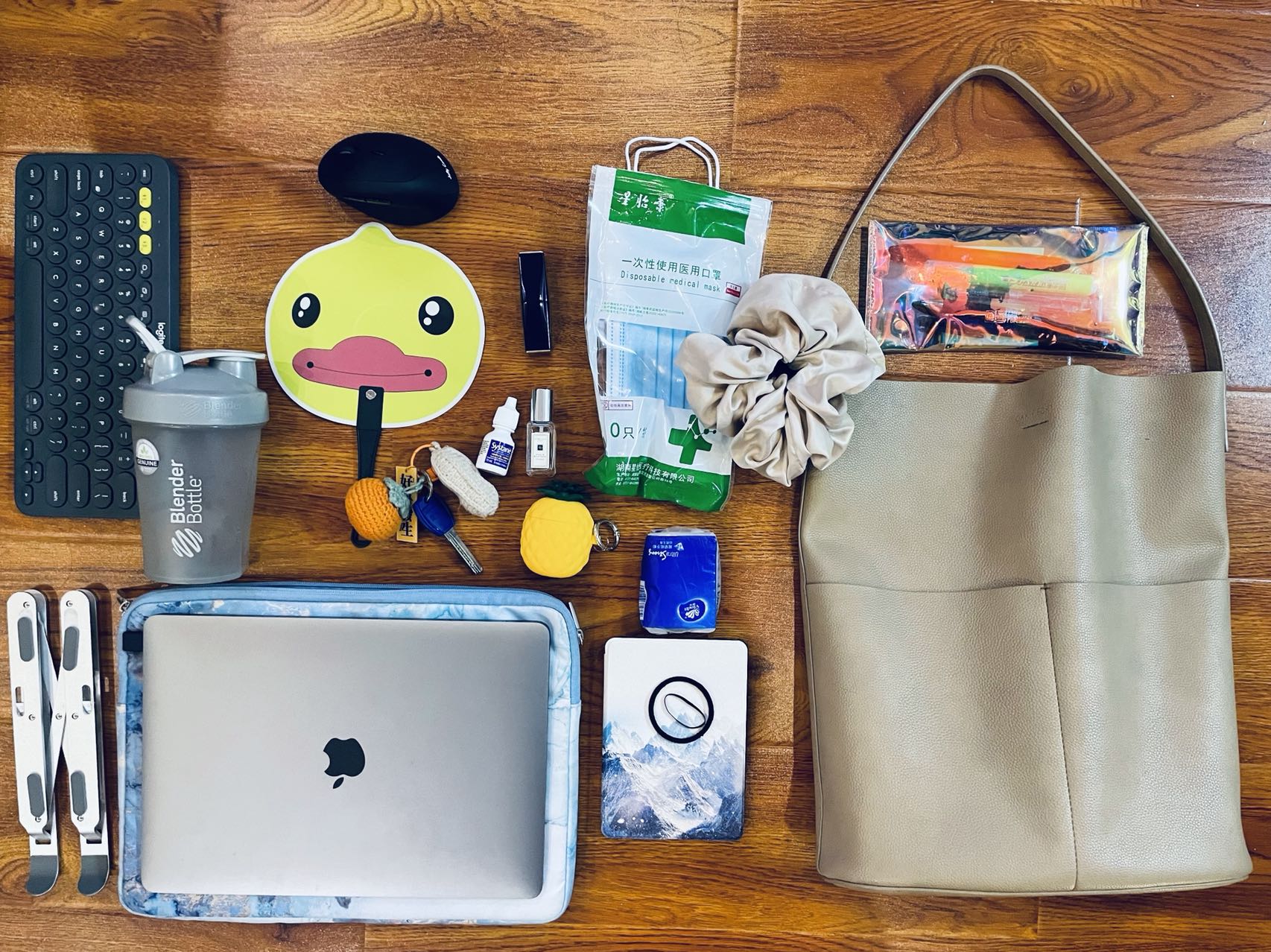Weekly Task 1 -What is in my bag?

What is your daily need for the items in your bag?
- I carefully examined the items in my bag:
- Laptop, laptop stand, mouse, and keyboard for work and study;
- Headphones help me to focus while working/studying in a coffee shop or library;
- A small fan as weather is getting hotter;
- Masks, napkins, hand sanitizer for COVID preventative measures;
- masks are still mandatory in China for any public indoor spaces;
- napkins as some public washrooms here don’t have toilet paper;
- E-book for casual and also pdf journal reading;
- A small container of perfume;
- House keys (handmade crocheting keychain during my 28-day quarantine);
- Hair ties: I like to tie up my hair when I’m studying, working, and eating;
- Eye drop: I’m suffering from dry eyes due to excess screen time.
- My phone (which is not in the picture);
- I don’t have a wallet as you can do anything and get anywhere with just a phone in China: to show health code, proof of vaccine, wallet for payment, various apps for taxi, bike share, e-ID card, etc.
- My daily life needs are primarily using devices (my phone) to connect with people on social media, to purchase stuff, and to show my health code to enter any public spaces. Also my life needs are based on my laptop, which I use to work (planning for my lessons, connecting with colleagues, etc.) and study (to read and work on this course).
- My life is pretty much occupied by work and study at the moment.
How might these items be considered “texts” and what do they say about you, the places you inhabit, the cultures with which you engage, and/or the activities you take up?
- Anyone can own the same bag. However, the items I place inside created my personal space, which is unique only to me. It is a creation process with items woven into each other based on their functionality, representing snapshots of me, which can be understood by others from examining the items.
- From the image, my life seems to be occupied by work and school primarily, which needs a lot of laptop time. I have been suffering from neck/eye/wrist problems due to excess laptop use. That’s why I carry a laptop stand, ergonomic mouse, and a separate keyboard everywhere.
- I have to carry masks everywhere with me as it is still mandatory in China.
- I don’t need cash/wallet as we use Wechat and Alipay here in China from the apps. No body ever carries cash or bank cards anymore in my city.
Thinking about the title of the course, what are the “text technologies” in your bag, if any? What do these items say about how you engage with language and communication?
- I carry the slim e-book in stead of physical books to read for pleasure.
- I use devices such as laptops and phones to browse for news, get information around the world, and connecting with people with text messages, voice messages, voice and video calling.
- QR codes are everywhere in China. I scan them with my phone to order for food, payment, navigating on maps, finding bike share and taxis, etc.
What do the items in your bag say about the literacies you have?
- Digital literacy: read/browse for information online (understanding visual text, image, videos, and podcasts); “writing” messages and communicating through text messages; able to use the phone for various apps for ordering food and taxi; navigating for direction; show proof of vaccination and COVID tests, etc.
How does the narrative of the (private) contents of your bag compare with the narrative produced by image you have of yourself or the image you outwardly project?
- I clear out my bags and change bags constantly so it doesn’t have much of a hidden part. I would say the private contents well-project myself and my personal life. I heavily rely on my laptop, phone, and headphones and I use them all the time.
What would this same bag have looked like, say, 15 or 25 years ago?
- Probably wouldn’t need to carry masks around pre-pandemic time;
- e-books were not as popular, so I would carry around physical books instead, including heavy textbooks;
- Smart phones were not that popular (I owned my first iPhone 1 around 13 years ago); I would have no access to phones or an old flip phone.
- Airpods didn’t exist, so I would be using wired headphones everywhere, and connecting to some kind of CD or tape player for music.
- Laptops were not that common or they were pretty thick. There would be notebooks and pens for writing; newspaper/magazines for reading for news.
How do you imagine an archeologist aiming to understand this temporal period might view the contents of your bag many years in the future?
- Written texts are not the dominant way of creation and communication anymore. I wonder how archeologist might look into personal laptops and phones many years in the future as they might not have access to the content as easy as written texts.